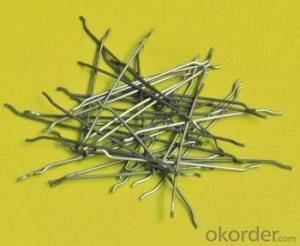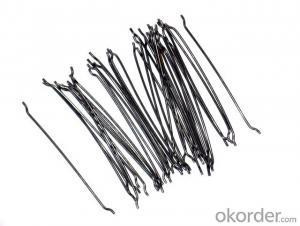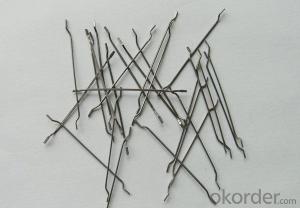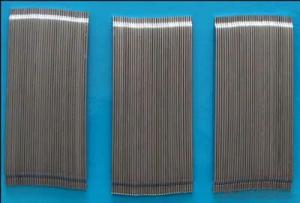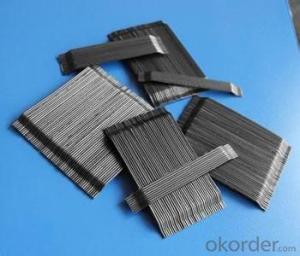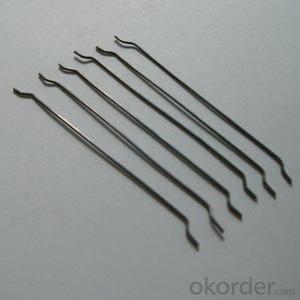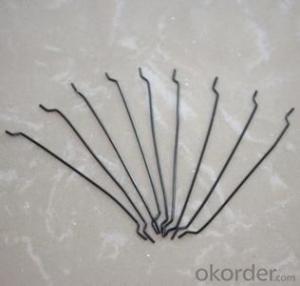Melt Extract Stainless Steel Fiber Reinforced Loose Concrete and Glued Concrete Reinforcement
- Loading Port:
- Tianjin
- Payment Terms:
- TT OR LC
- Min Order Qty:
- 5 kg
- Supply Capability:
- 30000 kg/month
OKorder Service Pledge
OKorder Financial Service
You Might Also Like
Quick Details
| Place of Origin: | Shandong, China (Mainland) | Brand Name: | cnbm | Material: | Steel |
| MATERIAL: | LOW CARBON STEEL WIRE | APPLICATION: | CONCRETE REINFORCED | STANDARD: | ISO9001 ASTM A820 |
| TYPE: | GLUED STEEL FIBER |
Specifications
Glued hooked steel fiber: Glueding single hooked steel fiber one by one in line with water soluble glue to keep the steel fibers evenly dispersed, no gobbet
Low carbon steel fiber for building construction
1.Diameter:0.4mm-1.2mm
2.Length: 25mm-60mm
3.Material: low carbon steel wire
4.Feature: 1100Mpa , excellent tensile,high tenacity,against cracking,impact and fatigue
5.Uses: highway road surface,tunnel,building,airport road surface and so on .
Picture
Steel fiber



FAQ
certificated: ISO 9001
Technical advantages of Daye steel fiber:
A. Improve mechanical performance of concrete
B. Provide uniform distribution throughout concrete with excellent mixing
C. No balling or caking by adopt correct mixing method
D. Reduce concrete volume
E.Save construction time and cost
F.Reduce excavation volume
G.Available for jointless floor.
- Q: How does melt extract stainless steel fiber improve the resistance to impact loading in concrete?
- The unique properties and characteristics of melt extract stainless steel fiber lead to a significant improvement in the resistance of concrete to impact loading. These fibers act as reinforcement when added to concrete mixtures, dispersing throughout the mixture and creating a three-dimensional network that strengthens the overall structural integrity. One way in which melt extract stainless steel fiber enhances impact resistance is by increasing the tensile strength of the concrete. Concrete is strong in compression but weak in tension. However, the addition of stainless steel fibers improves its tensile strength, allowing it to withstand impact forces better. These fibers bridge cracks and distribute the load, preventing crack propagation and reducing the risk of failure under impact loading. Moreover, the high aspect ratio of melt extract stainless steel fibers, combined with their excellent bonding properties with the concrete matrix, creates a strong interfacial bond. This bond effectively transfers impact energy from the concrete to the fibers, dissipating the energy and preventing localized damage. As a result, concrete with stainless steel fibers exhibits improved impact resistance, withstanding higher impact loads without significant damage or failure. Additionally, melt extract stainless steel fibers enhance the durability of concrete by reducing the formation and spread of microcracks. These fibers provide a reinforcement system that prevents cracks from widening and spreading, improving the longevity and service life of the concrete structure. By mitigating the effects of impact loading, the fibers contribute to reducing maintenance costs and extending the lifespan of the concrete. In conclusion, melt extract stainless steel fiber enhances the resistance of concrete to impact loading by increasing its tensile strength, preventing crack propagation, dissipating impact energy, and improving durability. These fibers play a crucial role in strengthening the overall structural integrity of concrete, making it more robust and resilient against impact forces.
- Q: Does melt extract stainless steel fiber affect the color or appearance of concrete?
- No, melt extract stainless steel fiber does not affect the color or appearance of concrete. This type of fiber is typically added to concrete mixtures as a reinforcement material, rather than for aesthetic purposes. The fibers are usually small and thin, and when mixed into the concrete, they blend in with the rest of the materials and do not alter the color or appearance of the finished product. The primary function of melt extract stainless steel fibers is to improve the strength and durability of the concrete, making it more resistant to cracking and enhancing its overall performance.
- Q: Can melt extract stainless steel fiber be used in architectural concrete?
- Indeed, melt extract stainless steel fiber is a viable option for incorporating into architectural concrete. Its utilization is widespread in architectural concrete projects owing to its impressive strength and durability. By reinforcing the concrete, it aids in bolstering its resistance against cracking, shrinkage, and impact, thereby augmenting the overall performance and lifespan of the structures. Moreover, the inclusion of melt extract stainless steel fiber in architectural concrete also fortifies its resistance against corrosion, rendering it suitable for implementation in architectural endeavors that face exposure to harsh environmental conditions. In summary, the integration of melt extract stainless steel fiber into architectural concrete not only enhances its structural integrity but also elevates its aesthetic allure.
- Q: Can melt extract stainless steel fiber be used in self-compacting concrete applications?
- Yes, melt extract stainless steel fiber can be used in self-compacting concrete applications.
- Q: How does melt extract stainless steel fiber improve the resistance to seismic loading in concrete?
- Melt extract stainless steel fiber improves the resistance to seismic loading in concrete by enhancing its overall strength and durability. The inclusion of these fibers in concrete mixtures helps to reinforce the structure, preventing cracks and fractures caused by seismic activity. The stainless steel fibers act as a network of reinforcement, increasing the tensile strength and ductility of the concrete. This reinforcement enables the concrete to better withstand the dynamic forces and vibrations experienced during seismic events, ultimately improving its resistance to seismic loading.
- Q: Are there any limitations or drawbacks of using melt extract stainless steel fiber in concrete?
- Yes, there are some limitations and drawbacks of using melt extract stainless steel fiber in concrete. Firstly, one limitation is the high cost associated with melt extract stainless steel fibers. Compared to other types of fibers, such as polypropylene or glass fibers, stainless steel fibers can be significantly more expensive. This can make the overall cost of using stainless steel fibers in concrete higher, which may be a deterrent for some construction projects with budget constraints. Secondly, the addition of stainless steel fibers can increase the viscosity of the concrete mix, making it more difficult to work with during placement and finishing. This can result in longer construction times and increased labor costs. Furthermore, stainless steel fibers can cause issues with corrosion in certain environments. While stainless steel is known for its resistance to corrosion, in some aggressive environments, such as chloride-rich or acidic environments, stainless steel fibers can still corrode. This can lead to a reduction in the durability and performance of the concrete over time. Another drawback of using stainless steel fibers is the potential for fiber balling. During the mixing process, the fibers can clump together, forming fiber balls. These fiber balls can result in an uneven distribution of fibers within the concrete, leading to reduced reinforcement efficiency and potentially compromising the structural integrity of the concrete. In addition, the use of stainless steel fibers can affect the workability of the concrete mix. The fibers can cause segregation, resulting in a non-uniform distribution of aggregate and cement paste. This can lead to a decrease in the overall strength and durability of the concrete. Lastly, the addition of stainless steel fibers can also impact the appearance of the concrete surface. The fibers may be visible on the surface, which can be undesirable in certain architectural or decorative applications. In conclusion, while melt extract stainless steel fibers offer improved mechanical properties and durability to concrete, they also have limitations and drawbacks including high cost, increased viscosity, potential corrosion, fiber balling, reduced workability, and impact on the concrete surface appearance. These factors need to be carefully considered when deciding whether to use melt extract stainless steel fibers in concrete.
- Q: How does melt extract stainless steel fiber improve the resistance to fire in concrete?
- Melt extract stainless steel fiber improves the resistance to fire in concrete by providing enhanced structural integrity and insulation properties. When added to concrete, these fibers are evenly distributed throughout the mixture, creating a three-dimensional network that reinforces the material. During a fire, the stainless steel fibers act as a heat sink, absorbing and distributing the heat, preventing localized hotspots and thermal cracking. This reduces the risk of spalling, which is the ejection of concrete fragments due to rapid heating and release of steam. By maintaining the concrete's structural integrity, the fibers help to prevent collapse during a fire, ensuring the safety of occupants and protecting the overall structure. Moreover, the stainless steel fibers also contribute to the concrete's insulation properties. They create a barrier that slows down the transfer of heat, reducing the temperature rise on the unexposed side. This insulation effect helps to maintain the stability of the concrete and prolong its ability to withstand high temperatures. Additionally, melt extract stainless steel fibers have excellent corrosion resistance, which is crucial in high-temperature environments. Unlike other reinforcing materials, such as traditional steel bars, these fibers do not rust or degrade when exposed to fire or moisture. This resistance to corrosion ensures the long-term durability and performance of the concrete, even after fire exposure. In summary, melt extract stainless steel fiber improves the resistance to fire in concrete by providing reinforcement, heat absorption, insulation, and corrosion resistance. By incorporating these fibers, concrete structures can withstand high temperatures, prevent spalling, and maintain their structural integrity during a fire, ultimately enhancing the safety and longevity of the building.
- Q: Can melt extract stainless steel fiber be used in concrete pipes and culverts?
- Yes, melt extract stainless steel fiber can be used in concrete pipes and culverts. The addition of stainless steel fiber enhances the strength, durability, and crack resistance of the concrete, making it better equipped to withstand the demanding conditions and stresses typically encountered in pipes and culverts.
- Q: Does melt extract stainless steel fiber improve the fatigue resistance of concrete?
- Yes, melt extract stainless steel fiber can improve the fatigue resistance of concrete. Stainless steel fibers are known for their high tensile strength and excellent corrosion resistance properties. When added to concrete, these fibers act as reinforcement and help to distribute stress more evenly throughout the material, reducing the likelihood of cracking and failure under cyclic loading conditions. The addition of melt extract stainless steel fiber to concrete can significantly enhance the fatigue resistance of the material. The fibers help to absorb and dissipate energy during loading and unloading cycles, thereby reducing the accumulation of microcracks and increasing the overall durability of the concrete. This improved fatigue resistance is particularly beneficial in structures subjected to repetitive or dynamic loading, such as bridges, pavements, and industrial floors. Furthermore, melt extract stainless steel fibers have a high aspect ratio, meaning they have a relatively large length compared to their diameter. This aspect ratio allows the fibers to effectively bridge across cracks that may occur in the concrete, preventing their propagation and enhancing the overall structural integrity of the material. In summary, the addition of melt extract stainless steel fiber to concrete can greatly improve its fatigue resistance by enhancing its ability to withstand cyclic loading. This reinforcement helps to prevent crack formation and propagation, resulting in a more durable and long-lasting concrete structure.
- Q: What is the recommended spacing between melt extract stainless steel fibers in concrete?
- The spacing between melt extract stainless steel fibers in concrete can vary depending on several factors, including the intended use of the concrete, the type of structural element, and the desired performance characteristics. However, a commonly recommended range for spacing is between 1 inch (25 mm) and 2 inches (50 mm). This range allows for a sufficient distribution of fibers throughout the concrete matrix, which enhances its tensile strength, crack resistance, and durability. To ensure the proper spacing for the specific stainless steel fibers being used, it is important to refer to the product guidelines and engineering specifications provided by the manufacturer. Additionally, seeking guidance from a structural engineer or concrete expert can offer further insight tailored to the project requirements.
Send your message to us
Melt Extract Stainless Steel Fiber Reinforced Loose Concrete and Glued Concrete Reinforcement
- Loading Port:
- Tianjin
- Payment Terms:
- TT OR LC
- Min Order Qty:
- 5 kg
- Supply Capability:
- 30000 kg/month
OKorder Service Pledge
OKorder Financial Service
Similar products
Hot products
Hot Searches
Related keywords









